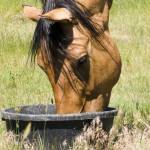Feeding Frequency

In free-ranging situations, horses and ponies typically spend 50-75% of each day grazing. Continuous ingestion of feedstuffs keeps the digestive tract running smoothly. Modern management practices dictate that many horses remain in confinement for long periods of time with limited or no access to pasture. While confinement deviates considerably from their grazing roots, horses can be fed safely and successfully when housed in stalls, paddocks, and drylots.
Liberal access to long-stemmed, high-quality forage such as pasture or hay satisfies the energy requirements of many horses. A forage-only diet, however, is unlikely to provide sufficient energy (or proper quantities and proportions of nutrients) for growth, lactation, or intense work. When energy requirements cannot be fulfilled by forage alone, concentrates (as textured or pelleted feed) are fed to bridge the gap.
Pinpointing energy needs beyond those provided by forage may reveal that only a small amount of concentrate is necessary. A single meal a day may suffice, but only if the horse is being fed 0.5 lb feed/100 lb of body weight (0.2 kg feed/42 kg body weight) or less. For a 1000-pound (450-kg) horse, for instance, this would be equivalent to 5 pounds (2.2 kilograms) of feed daily. If more than 0.5 lb feed/100 lb body weight (0.2 kg feed/42 kg body weight) is required, the horse should be fed in two or more meals. Growing young stock, milking mares, and working horses may require more than 1 lb feed/100 lb of body weight (0.45 kg feed/42 kg body weight). In such instances, the concentrate should be divided equally into three or more evenly spaced meals.
Feeding the average-size horse more than five pounds (2.2 kilograms) of concentrate in one meal is an invitation for digestive dysfunction, including colic and laminitis. The starch fraction of a concentrate meal of five pounds or less is easily digested and absorbed in the small intestine. As meal size increases, some starch dodges the workings of the small intestine and proceeds to the hindgut, which is comprised of the cecum and the colon. The resident microflora of the hindgut (bacteria, protozoa, and fungi) must work double-time to break down the wayward starch. This upsets the ecology of the hindgut and produces excessive lactic acid. As lactic acid builds up in the hindgut, a rapid die-off of microflora ensues, purging harmful endotoxins into the bloodstream. This sudden influx of soluble carbohydrates into the hindgut is termed grain overload.
Remember these tips when deciding when and how often to feed concentrates to horses and ponies:
• Feed concentrates only when forage does not meet energy and nutrient requirements.
• Feed at regular and even intervals. For twice a day offerings, feed 12 hours apart; for tridaily offerings, feed every eight hours.
• Feed meals in equal portions.








